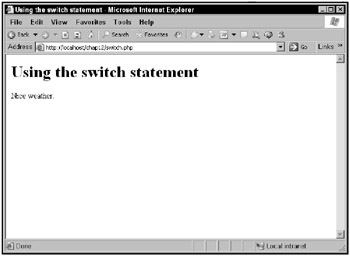Using Switch Statements
You create a switch statement with the keyword switch, and you indicate the item you’re testing by placing it in parentheses. You create multiple tests using the case statement, specifying a value for each such statement. If the switch’s test value matches a case statement’s value, the internal statements in the case statement are executed up to a break statement, which ends the case statement. If no case matches, the statements in a default statement, if present, are executed.
Here’s what the switch statement looks like:
switch (expression){ case data: statement break; case data: statement break; case data: statement break; [default: statement] } | Note | If the value of expression doesn’t match any data item, the code in the optional default statement will be executed. |
In this example, different text based on the temperature, switch.php, is displayed:
<html> <head> <title> Using the switch statement </title> </head> <body> <h1> Using the switch statement </h1> <? $temperature = 75; switch ($temperature){ case 75: echo "Nice weather."; break; case 76: echo "Still nice weather."; break; case 77: echo "Getting warmer."; break; default: echo "Temperature outside the range."; } ?> </body> </html> You can see switch.php at work in Figure 12.12, which shows that it’s nice weather.

Figure 12.12: Using switch statements